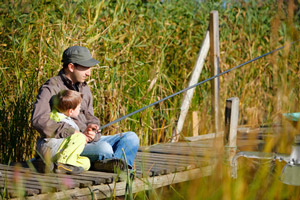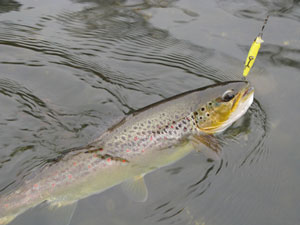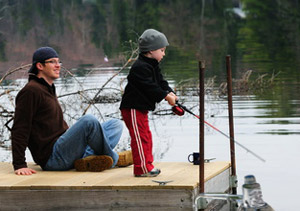Pond Resource Management
At Bo-Jo Fishlight, we of course sell fishing light products for pond, lake and stream situations. We feel that our lights can be a useful contribution to nearly any pond or lake management plan. They are a cost effective, ecologically responsible, natural feeding device that gives your fish a high protein food source that they actually enjoy.
Whether you have a fishing pond or a koi pond, a Bo-Jo light might be a useful addition to your management plan.
 Let’s face it. Bo-Jo Fishlight or not, good fishing in ponds seldom happens without careful planning and management. For successful recreational fishing, ongoing management is critical. Two outstanding free guides to pond management are linked at the bottom of this page.
Let’s face it. Bo-Jo Fishlight or not, good fishing in ponds seldom happens without careful planning and management. For successful recreational fishing, ongoing management is critical. Two outstanding free guides to pond management are linked at the bottom of this page.
Fish Pond Basics
To maximize the Carrying Capacity of your pond, you need to maintain a balance of population, stocking and harvesting. Beyond the Nitrogen/Potassium/Phosphorous mix of your pond’s ecosystem, a pond’s basic building block for its aquatic food pyramid is phytoplankton (a microscopic algae), that is then consumed by zooplankton.
 Zoo plankton is then eaten by crustaceans like snails, aquatic insects, and juvenile fish. Forage fish species such as bream next gobble up the snails, insects and smaller fish. The forage species then become prey to the predator fish species in your pond, such as largemouth bass.
Zoo plankton is then eaten by crustaceans like snails, aquatic insects, and juvenile fish. Forage fish species such as bream next gobble up the snails, insects and smaller fish. The forage species then become prey to the predator fish species in your pond, such as largemouth bass.
If you want to harvest more and bigger fish, we recommend that you fertilize your pond to increase its carrying capacity (total fish production).

Fishing (Harvesting) is Important!
Your fish harvest should be spread out over the year, and removal of a ratio three to four times higher (in pounds) of forage fish to predatory fish is strongly recommended by experienced pond managers. Many people keep logs of their fishing.
Pond Considerations

An ideal pond for fishing has areas of deep water, as well as more shallow, vegetated ares. To increase your pond’s fishing potential, your pond needs depth for larger fish and shallows for spawning areas.
The U.S. Natural Resources Conservation Service (NRCS), (formerly the U.S. Soil Conservation Service) provides some basic management advice for ponds. Their Farm Pond Ecosystem brochure (link) contains the following core advice:
Farm ponds managed for fish production should be approximately 6 to 10 feet deep, depending on the desired species to be stocked, and at least a half acre in size. A minimum depth of 8 feet should comprise at least 1,000 square feet of the pond to be suitable for fish stocking.
It is important to incorporate fish spawning areas, or shoals, when designing a farm pond for fish production. Spawning shoals are structures such as underwater sand bars or rock piles that provide shallow areas for breeding fish. Shallow water shoals can be created by adding multiple rows of large-sized rocks to the bottom of certain portions of the pond. Nylon mats can also be used as artificial spawning sites for stocked species such as largemouth bass. Placing a number of boulders, approximately 2 to 3 feet in diameter, along the bottom of the pond may also augment fish habitat. These boulders will provide resting cover to fish populations.
Fish !!!

Common fish stocked in ponds in the Southeastern US include largemouth bass, bluegill and redear sunfish (aka “shellcracker”). Prior to the introduction of fish, you need to decide whether pond fertilization will be included in your long-term pond management. Fertilized ponds are generally stocked at the rate of 1,000 bream (a combination of bluegill and shellcracker at a 3:1 ratio) and 100 largemouth bass per acre. A pond that will not be fertilized should be stocked at only half the above rate.
Crappie and hybrid bream (“Georgia giants”) may also do well in larger lakes. They compete with bream and bass for food, so in pond situations they generally overcrowd other species, causing a population imbalance.
Managing Your Pond for Success

The South Carolina Department of Natural Resources authored an outstanding short guide in 2009, outlining and illustrating many of the basic requirements to successfully manage your pond. Fishing is prominently featured in the booklet, which is linked (here).
The State of Ohio also authored very good, 50-page Pond Management Guide in 1996. It is linked (here).